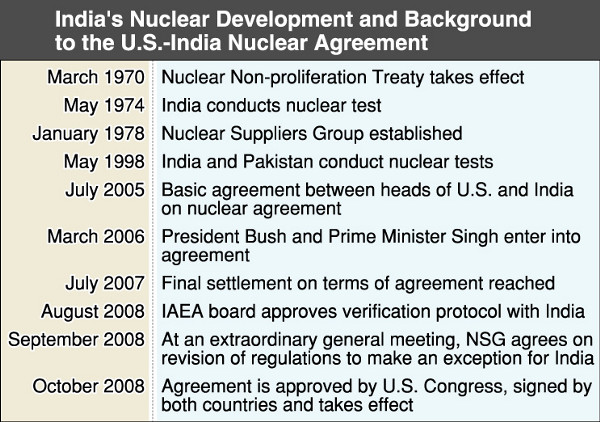Nuclear weapons can be eliminated: Chapter 1, Part 6
Mar. 16, 2009
Chapter 1: Superpower at a turning point
Part 6: U.S.-India Nuclear Agreement
by Yumi Kanazaki, Staff Writer
Concern about double standard amid praise for IAEA monitoring
The bilateral nuclear agreement between the United States and India may throw cold water on efforts to halt nuclear proliferation. While President Barack Obama has stated his belief in the importance of the Nuclear Non-proliferation Treaty, he voted in favor of the U.S.-India agreement last fall when he was a senator.
The offices of the Arms Control Association, publisher of the journal Arms Control Today, are located in a building within the business district, a 10-minute walk from the White House. Research analyst Peter Crail, 29, discussed the demerits of the agreement with India. “This sets a precedent by allowing a country that has not signed the NPT to possess nuclear weapons, to import nuclear fuel, and to reprocess spent fuel. It thus weakens the persuasiveness of the argument that Iran, which has signed the NPT, must abandon its nuclear development program,” he said.
Along with Pakistan and Israel, India has refused to sign the NPT. Japan and other members of the Nuclear Suppliers Group have supported the NPT framework by restricting nuclear energy-related exports to these countries.
In 2005, however, the heads of the U.S. and India agreed on the bilateral nuclear energy deal. Last summer, before the end of his term, former President George W. Bush exerted diplomatic pressure on other nations concerned. The board of the International Atomic Energy Agency, which inspects nuclear power facilities, and the NSG unanimously supported the agreement, but there were strong opposition movements among the American public as well as in Hiroshima and Nagasaki out of concern that the agreement would facilitate the development of nuclear weapons.
Zia Mian, 47, a nuclear physicist and researcher at Princeton University in New Jersey who specializes in security issues in South Asia, said with a trace of sarcasm, “In the end, they chose business over the prevention of nuclear proliferation. And the Japanese government, which went along with the U.S., is just as bad.”
On the other hand, there are those who view the agreement positively. Lisa Curtis, a senior research fellow at the Heritage Foundation, headquartered in Washington, said, “It is highly significant that some of the project is subject to monitoring by the IAEA and that it invites participation in the non-proliferation regime. The special treatment India has been given won’t set a bad precedent,” she said.
Ms. Curtis formerly worked in the State Department and the Central Intelligence Agency and is an expert on South Asia issues. “India is the world’s largest democracy. It’s not like Iran or Pakistan. The strengthening of the relationship between the U.S. and India will contribute to greater stability in Asia,” she added.
Nevertheless, changing the rules for one player, depending on who it is, creates a double standard. Mr. Crail, of the Arms Control Association, said an effort must be made to repair the damage the double standard has caused. He said there is a need to create strict international regulations for the enrichment of uranium and reprocessing, both of which can be used to produce weapons-grade nuclear materials.
U.S.-India Nuclear Energy Cooperation Agreement
Under the agreement between the two nations, the U.S. will export fuel for the generation of nuclear power and nuclear technology to India. Of its 22 reactors, including those under construction or in the planning stages, India has designated 14 reactors for inspection by the IAEA. Military facilities are not subject to inspection.
Nuclear Suppliers Group
The Nuclear Suppliers Group was established in 1978 at the initiative of the U.S. after India conducted nuclear tests. The NSG provides an international framework for the creation of regulations to prevent the diversion of materials and fuel for nuclear power generation to use for weapons. The NSG has 45 member nations, including Japan where its headquarters are located.
(Originally published on February 17, 2009)
To comment on this article, please click the link below. Comments will be moderated and posted in a timely fashion. Comments may also appear in the Chugoku Shimbun newspaper.








